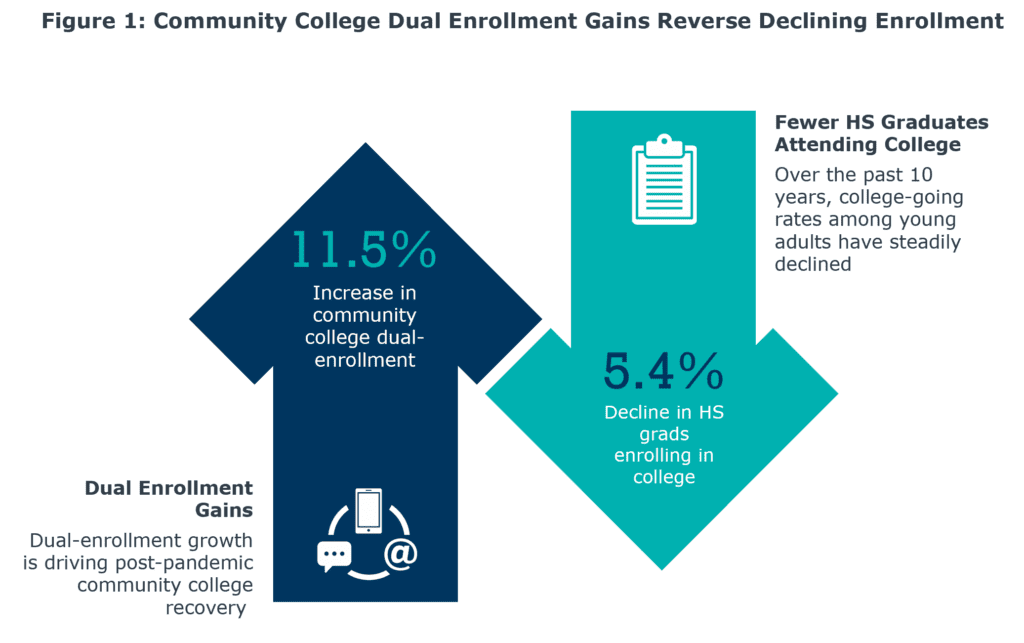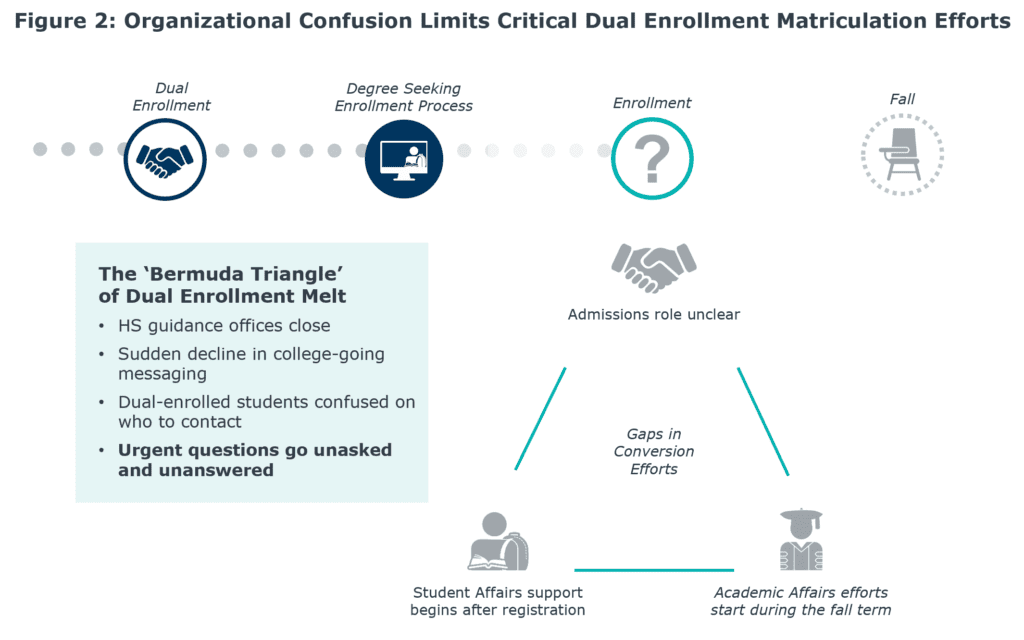How dual enrollment can combat enrollment declines
This story was originally published in the League for Innovation’s Innovatus Magazine (March 2023).
Since 2020, enrollment at community colleges has declined 5.4 percent,1 which has prompted institutions to reflect on practices that impact student success and on barriers students face in their pursuit of higher education. Most of the enrollment that has been recovered at community colleges is through an uptick in dual enrollment. As of fall 2022, enrollment declines at community colleges had slowed to 0.4 percent compared to the prior fall, driven entirely by the growth of dual enrolled high school students (+11.5 percent) and 18- to 20-year-old students (+1.4 percent).2
While this growth in dual enrollment is encouraging, college-going rates for high school graduates have steadily declined over the past decade. Even as high school graduation rates climbed by 7.6 percent since 2010, college-going rates declined by 5.4 percent.3 And while students who participate in dual enrollment are historically more likely to go on to college, the pandemic has shifted the focus of some young adults to full-time employment, family obligations, and alternatives to traditional postsecondary education. This shift makes it imperative for community colleges to keep dual enrolled students highly engaged if they intend to retain them.

External threats to keeping your dual enrolled students
Today’s prospects are considering a wider set of institutions at every stage of the funnel. For enrollment leaders, this means that students’ attention is increasingly divided. Data from EAB student surveys and partner institutions have shown a steady increase in the average number of applications per student from just over six to seven across the pandemic.4 Knowing that dual enrollment students are likely casting a wider net when considering their long-term college options means that early, targeted communications with these students is vital in order to successfully stand out among their other options.
In addition, more students may be open to nontraditional pathways to access postsecondary knowledge. A national survey conducted in 2022 suggests that the number of high school juniors and seniors planning to attend fully online colleges has more than doubled since before the pandemic, despite the fact that the majority of these colleges do not market to younger students.5
Compounding the lure of multiple education pathways are rising wages among young adults. Many students who may be considering attending community college are having to weigh their need to provide for themselves and their loved ones with their desire to attend college. And often, financial obligations take precedence over postsecondary education pursuits. Atlanta Federal Reserve’s Wage Growth Tracker6 shows that the 12-month moving average of median hourly wage growth stands at 3.8 percent overall. In 2022, this number jumps up to 10.5 percent for 16- to 24-year-olds,7 demonstrating that young adults are gaining access to better paying jobs, which can press pause on their college-going plans.
Internal threats to keeping dual enrolled students
Even for students who haven’t opted out of college, getting through the enrollment process can be a challenge, and younger students have high expectations of rapid and tech-enabled processes. Unfortunately, during the pandemic, it took community college students an average of three weeks to register for courses after being admitted,8 significantly slowing student momentum. The swirl caused by redundant processes can result in unnecessary visits to campus and frustration,9 and cause community colleges to spend time course-correcting to get students on track.
EAB’s secret shopper research10 shows the largest barriers to community college enrollment are:
- High school transcript requirements
- Inaccessible staff
- Delayed acceptance or ID delivery
- No (or limited) nudges about next steps
- No guidance on program choice
- No guidance and limited website information regarding transfer options
Younger students, who have always had access to instant information, expect a rapid and transparent turnaround when interacting with colleges. Uncluttering the enrollment process and providing clear, concise, easy-to-understand calls to action will become even more paramount as higher numbers of young students explore their college options.

Finally, with changes in staffing levels both at high schools and community colleges, having enough hands to keep dual enrollment students moving forward has been a challenge. Student-facing professionals such as advisors and admissions staff have been difficult to retain, and this lack of bandwidth can create bottlenecks in engaging dual enrollment students through to continued enrollment.
How can community colleges innovate to drive dual enrollment engagement?
- Offer Early Admission: Providing early admission to your college and prioritizing enrolling students before they graduate high school can help students to maintain their dual enrollment momentum. For example, Houston Community College has begun to close the gaps on retaining younger students through their PSOAR program, which provides early admission and helps students complete their enrollment before summer break.11
- Engage Families: During the pandemic, students relied more on their families when making decisions about college, but first-generation students were 23 percent less likely than successive-generation students to name their families as a top resource.12 Knowing that community colleges service many first-generation students, it’s important to pull their families into the conversation early to make sure everyone’s questions are answered. Consider holding information sessions that are explicitly for dual enrolled students and their families and that outline your value proposition and specific enrollment steps. This will help to build trust and eliminate confusion.
- Streamline Onboarding: At Pikes Peak Community College, in 2016 only 20 percent of students were matriculating directly from high school, and 60 percent of applicants never enrolled.13 After discovering that 93 percent of non-enrolled applicants did not go on to enroll at another institution, college leadership decided to survey lost applicants. Student responses revealed numerous communication breakdowns, including long turnaround times, unclear messaging, and inflexible practices. By leveraging self-guidance technology, offering 1:1 advising after hours, and streamlining placement testing processes, advising appointments increased 7 percent in one year (2017). And students who engaged with self-guidance technology were twice as likely to register for classes than those who did not.
- Focus on Flexibility: As wages for young adults climb, the strategies that have historically attracted working adults are becoming more applicable to young adults. These are students who are interested in ROI,14 hybrid and online programs, short-term options, and workforce training. Using dual enrollment connections as a vehicle to showcase the variety of paths forward—not just a traditional campus-bound associate degree—can help keep the attention of students who are actively seeking the highest return on both their time and financial investment.
- Leverage Summer Melt Strategies: Converting dual enrollment students doesn’t stop once they have applied to the college as degree-seeking students. Make sure each student service area is informed of its role in working with former dual enrollment students, what students’ specific enrollment milestones are, and which enrollment steps students may get to skip. This is critical in ensuring that students stay on track. After registration, these students still need college support, especially if they registered earlier in the spring, because they lose their existing dual enrollment infrastructure, such as guidance counselors and dedicated dual enrollment advisors.
Sources
- 1 National Student Clearinghouse Research Center. (2022). Stay Informed with the Latest Enrollment Information.
- 2 National Student Clearinghouse Research Center. (2022). Stay Informed with the Latest Enrollment Information.
- 3 EAB Analysis of American Community Survey Data. (2021). McKinsey and Co.
- 4 EAB. (2022). Gen Z’s Changing Journey to Enrollment.
- 5 Agostino, S. (2022, October 14). A Surge in Young Undergrads, Fully Online. Inside Higher Ed.
- 6 Federal Reserve Bank of Atlanta. (2022). Wage Growth Tracker.
- 7 Washington State Council of Presidents. (2022, February 16). Trends in Wage Growth and College Enrollment.
- 8 EAB. (2022, July 21). 3 ways to combat the community college enrollment decline.
- 9 EAB. (2017, March 3). How three simple community college onboarding changes turned into $70K at Danville Community College.
- 10EAB (2017). The Four Biggest Onboarding Mistakes Community College Teams Make
- 11 Houston Community College. (n.d.). Alief I.S.D. Partnership.
- 12 EAB. (2022). Gen Z’s Changing Journey to Enrollment.
- 13 EAB. (2020). 2020 Case Study Compendium, p. 7.
- 14 Bill & Melinda Gates Foundation. (2022, September 28). Where Are the Students? New Research into College Enrollment Declines.
Ready to find out more?
Fill out the form and someone from our team will get back to you with more information.

More Blogs

Six steps community colleges can take now to prepare for Workforce Pell

6 barriers to enrollment community college students face
